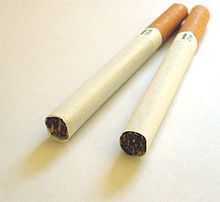Marlboro (cigarette)
 | |
| Product type | Cigarette |
|---|---|
| Produced by | Philip Morris USA, Philip Morris International |
| Introduced | 1904[1] |
Marlboro (US /ˈmɑrbᵊroʊ/,[2] UK /ˈmɑːlbᵊrə/ or UK /ˈmɔːlbᵊrə/[3]) is the largest selling brand of cigarettes in the world. It is made by Philip Morris USA (a branch of Altria) within the United States, and by Philip Morris International (now separate from Altria) outside the United States. It is well known for its billboard advertisements, magazine ads of the Marlboro Man, and its long associated history in the sponsorship of motorsport. Richmond, Virginia, is the location of the largest Marlboro cigarette manufacturing plant.
History
Philip Morris launched the Marlboro brand in 1924 as a woman's cigarette, based on the slogan "Mild As May". In the 1920s, advertising for the cigarette was primarily based around how ladylike the filter cigarette was, in an attempt to appeal to the mass market.[4] To this end, the filter had a printed red band around it to hide lipstick stains, calling it "Beauty Tips to Keep the Paper from Your Lips".[1]
After scientists published a major study linking smoking to lung cancer in the 1950s, Philip Morris repositioned Marlboro as a men's cigarette in order to fit a market niche of men who were concerned about lung cancer. At the time, filtered cigarettes were considered safer than unfiltered cigarettes, but had been until that time only marketed to women. Men at the time indicated that while they would consider switching to a filtered cigarette, they were concerned about being seen smoking a cigarette marketed to women.[1]
The red and white package was designed by the Designer Frank Gianninoto. The repositioning of Marlboro as a men's cigarette was handled by Chicago advertiser Leo Burnett. The proposed campaign was to present a lineup of manly figures: sea captains, weightlifters, war correspondents, construction workers, etc. The cowboy was to have been the first in this series. While Philip Morris was concerned about the campaign, they eventually gave the green light.[1]
Within a year, Marlboro's market share rose from less than one percent to the fourth best-selling brand. This convinced Philip Morris to drop the lineup of manly figures and stick with the cowboy,[1] later known as the Marlboro man. From 1963 the television advertisements used Elmer Bernstein's theme from The Magnificent Seven.
In order to comply with a 2006 court ruling in United States v. Philip Morris USA, Inc., et al.,[5] Philip Morris (and all other cigarette companies) is now prevented from using words such as "Lights", "Ultra-Lights", "Medium", "Mild", or any similar designation that yields a false impression that they are safer than regular full flavor cigarettes. Thus Marlboro and other cigarette companies must use only color-coding instead; for example Marlboro Lights are now called Marlboro Gold Pack.
Philip Morris responded to the popularity of Pall Mall, the number three brand, by pushing Marlboro Special Blends, a lower-priced cigarette.[6]
Last Week Tonight produced a TV episode which aired on February 15th 2015, with a segment about the tobacco industry. The comedian John Oliver created a new mascot for Phillip Morris International, the makers of Marlboro cigarettes, named Jeff the diseased lung. Jeff the diseased lung appeared on international billboards in Uruguay, t-shirts sent to Togo, and caused the creation of several YouTube videos and the hashtag '#JeffWeCan'.[7][8]
Motorsport sponsorship
Formula One
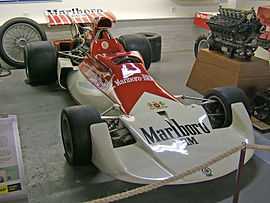
Marlboro is known for its sponsorship of motor racing. This started in 1972 with its sponsorship of Formula One teams BRM and Iso Marlboro-Ford. The former took one win at the very wet Monaco Grand Prix.
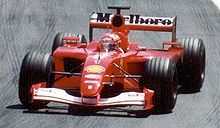
For 1974 Marlboro dissolved its sponsorship of both teams and became famously associated with the McLaren team, which brought it its first constructors' championship and its drivers title for Emerson Fittipaldi. The team was successful through to 1978, with another world champion in James Hunt in 1976. Following that the partnership went through a dry patch until Ron Dennis's Project Four Organisation took over the team in 1981. Marlboro-sponsored McLarens dominated F1 for much of the 1980s and early 1990s, with Niki Lauda, Alain Prost and Ayrton Senna between them winning the drivers' championship all but one year from 1984 to 1991. After the departure of Ayrton Senna in 1993, Marlboro McLaren did not win a race for three years. Marlboro ended their sponsorship of the team in 1996, which ended the famous red and white McLaren livery.
Marlboro also sponsored Scuderia Ferrari's drivers since 1973 (the brand appeared only on helmets and suits) but only in 1984 it became a minor sponsor on Ferrari's single-seaters; until then Enzo Ferrari allowed only technical suppliers brands to appear on his team cars. In 1993 Marlboro began to take over as the primary sponsor, and in 1997 became title sponsor as the team was officially named as Scuderia Ferrari Marlboro.
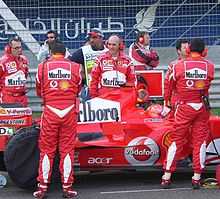
In September 2005 Ferrari signed an extension of their sponsorship arrangement with Marlboro until 2011. This agreement came at a time when tobacco sponsorship had become wholly illegal in the European Union and other major F1 teams ended their relationships with tobacco companies. In reporting the deal, F1 Racing magazine judged it to be a "black day" for the sport, putting non-tobacco funded teams at a disadvantage and discouraging other brands from entering a sport still associated with tobacco. The magazine estimated that in the period between 2005 and 2011 Ferrari received $1 billion from the agreement. Depending on the venue of races and the particular national laws, the Marlboro branding became largely subliminal in most countries. In April 2008 Marlboro displayed explicit on-car branding on Ferrari for the last time, then permanently replaced with a variety of barcodes in place of it. Since then there were calls from leading health officials, the European Commissioner for Health and influential doctors for a review of the subliminal advertising contract Marlboro has with Advertising Guerrilla and Ferrari, due to the implications of influencing the purchase of cigarettes with possible subliminal advertising, as no tobacco products can be promoted in sporting events in Europe by law.[9] The Ferrari team claimed the barcode was part of the car design, not an advertising message.[10]
The controversial barcode design was removed by Ferrari for the start of the Spanish Grand Prix in the 2010 season but the barcode remained on drivers team gear.[11] In January 2011, the Scuderia Ferrari presented a new logo for its racing team. This logo is considered by a specialised F1-website[12] as a subliminal advertisement for Marlboro, evocating the top-left corner design of a Marlboro cigarettes pack.
In June 2011, Ferrari extended its collaboration with Marlboro through to the end of 2015, despite cigarette advertising being banned in the sport.[13]
Marlboro also sponsored the Alfa Romeo F1 Team between 1980 and 1983, although unable to match up to its pre-war and 1950s heyday, the team only achieving one pole position, one fastest lap and four podium finishes.
Grand Prix motorcycle racing

Marlboro entered the motorcycling grand prix in the seventies as personal sponsor of riders like Giacomo Agostini, Angel Nieto and Jarno Saarinen. In 1976 Marlboro backed Agostini's team who raced MV Agusta bikes with little factory support.
Since 1983 the cigarette brand sponsored the Yamaha 500cc works team, who was managed by Agostini until 1989 and then by Kenny Roberts until 1996. During that period the Japanese bikes won six World Championship and, as a result of their sponsorship, Marlboro decals on race replica bikes became one of the most popular decal kits that were available.
In the nineties Marlboro's livery also appeared on other bikes, especially the Hondas entered by Team Pileri (from 1992 to 1995), Pons Racing (in 1993)[14] and Erv Kanemoto's team (in 1997 and 1998) who achieved the 1997 250cc World Championship with Max Biaggi.
The Yamaha works team was again associated with Marlboro between 1999 and 2002.
Since 2003 Marlboro sponsors the Ducati MotoGP team whom Casey Stoner took his first MotoGP title in 2007. As of the 2009 Grand Prix motorcycle racing season they were only allowed to brand the bikes at one round, in Qatar, using the barcode in other races. The controversial barcode design was then removed by Ducati for the start of the French motorcycle Grand Prix in the 2010 season. In January 2011 the Ducati Team presented a new logo.
Other racing series
Since their start in Formula One, Marlboro has also sponsored numerous teams and races, from Joest Racing in Group C in 1983 to Toyota at the 24 Hours of Le Mans in 1999 (despite a tobacco ban in France) and Marlboro Masters Formula Three race in Zandvoort.
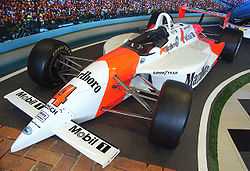
Marlboro sponsorship in IndyCar dates back to 1986. In 1990 Penske Racing started a 20 years-long association with Marlboro and its distinctive red and white livery. However in the 2007 season Marlboro logos were replaced with 'Team Penske' but the team retained the color scheme as Philip Morris USA was still Penske's main sponsor. 2009 was the last year of the Penske-Marlboro association.[15]
Marlboro also sponsored Holden Dealer Team from 1974 through to 1984. The Marlboro branding gave rise to some of Australia's most prominently recognizable race cars such as the L34 and A9X Torana, as well as the famous VK Group C "Big Banger" Commodore of Peter Brock and Larry Perkins Bathurst winning fame.
Marlboro also has a long history in rallying sponsorship, including with the factory World Rally Championship teams of Lancia (between 1972 and 1974), Toyota (notably with Freddy Loix until the end of 1998), Mitsubishi (to whom Loix moved from 1999 until 2001, with the iconic livery remaining on successive Lancer Evolutions until the marque's temporary WRC withdrawal at the end of 2002), and Peugeot, from 2003 to 2005. Marlboro also sponsored the cars of Emirati rally driver Mohammed bin Sulayem[16] and has sponsored a number of rallies in the Middle East, including the Rally of Lebanon,[17] the Jordan Rally,[18] and the UAE Desert Challenge.[19] From 2005 to 2007, GP2 Series team ART Grand Prix was also sponsored by Marlboro. Marlboro are generally credited as being among the most important of sponsors to the world of Formula 1 (and motor racing in general) in terms of the amount of financial backing given to various competitors. In mid-2006, special "racing editions" of Marlboro Red were sold in the UK, with a Ferrari-inspired design, although the Ferrari name and badge were not used. They also come in Menthols.
Varieties
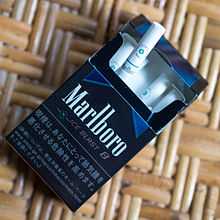
Phillip Morris International markets cigarettes,[20] snus,[20] and Heatsticks under the Marlboro brand.[21] They come in the following varieties of flavor and packaging:
International cigarette varieties
Philip Morris International organised Marlboro products into three divisions - Flavor line, which are original red/full flavor cigarettes, Gold line are former lights and Fresh line comprises flavoured cigarettes.[22][23][24][25][26]
- Flavor line:
- Marlboro Red
- Marlboro Core Flavor
- Marlboro Flavor Mix
- Marlboro Filter/Flavor Plus
- Marlboro Beyond
- Gold line:
- Marlboro Gold Original
- Marlboro Gold Touch
- Marlboro Gold Edge
- Marlboro Gold Advance
- Marlboro Gold Beyond
- Fresh line:
- Marlboro White Menthol
- Marlboro Black Menthol
- Marlboro Fresh
- Marlboro Ice Blast
- Marlboro Blue Ice
American cigarette varieties
- Marlboro - box, 25's box, soft pack
- Marlboro 100's - box, soft pack
- Marlboro Eighty-Threes - box
- Marlboro 72's - box
- Marlboro Red Label - box, soft pack
- Marlboro Red Label 100's - box, soft pack
- Marlboro Gold Pack - box, 25's box, soft pack
- Marlboro Gold Pack 100's - box, soft pack
- Marlboro Gold Pack 72's - box
- Marlboro Silver Pack - box
- Marlboro Silver Pack 100's - box
- Marlboro Silver Pack 72's - box
- Marlboro Blend No. 27 - box, soft pack
- Marlboro Blend No. 27 100's - box
- Marlboro Virginia Blend - box
- Marlboro Virginia Blend 100's - box
- Marlboro Southern Cut - box
- Marlboro Black - box
- Marlboro Black 100's - box
- Marlboro Edge - box
- Marlboro Special Blend Red - box
- Marlboro Special Blend Red 100's - box
- Marlboro Special Blend Gold - box
- Marlboro Special Blend Gold 100's - box
- Marlboro Menthol - box, soft pack
- Marlboro Menthol 100's - box
- Marlboro Menthol Green Pack 72's - box
- Marlboro Menthol Blue Pack - box
- Marlboro Menthol Blue Pack 100's - box
- Marlboro Menthol Blue Pack 72's - box
- Marlboro Menthol Rich Blue - box
- Marlboro Menthol Rich Blue 100's - box
- Marlboro Menthol Gold Pack - box, soft pack
- Marlboro Menthol Gold Pack 100's - box, soft pack
- Marlboro Menthol Silver Pack - box
- Marlboro Menthol Silver Pack 100's - box
- Marlboro Menthol Smooth - box
- Marlboro Menthol Smooth 100's - box
- Marlboro Menthol Skyline - box
- Marlboro Menthol Skyline 100's - box
- Marlboro Menthol Black - box
- Marlboro Menthol Black 100's - box
- Marlboro NXT - box
American snus varieties
- Marlboro Snus Original
- Marlboro Snus Mint
Heatsticks
- Marlboro Heatsticks are a heated tobacco product which produces a flavorful nicotine laden vapor. On June 26, 2014 Phillip Morris announced plans to introduce Heatsticks in cities in Italy and Japan.[21]
Marlboro in Canada
Philip Morris sold the Canadian rights to the "Marlboro" name to Imperial Tobacco Canada in 1932. After the brand's successful American relaunch in the 1950s – which later became well known to Canadians through exposure to the brand's international sponsorships and advertising – Philip Morris tried several legal manoeuvres in attempting to reacquire the Canadian rights, to no avail. Imperial Tobacco continues to sell a line of cigarettes under the Marlboro name in Canada, albeit with very different packaging from that of the Philip Morris product. Philip Morris retains the rights to the "rooftop" trade dress and other elements of Marlboro's branding which were developed after the 1932 sale, and has historically used that trade dress in Canada in combination with the names "Matador" or occasionally "Maverick" for a line of Virginia blend cigarettes.[27][28]
In 2006, Philip Morris International's Canadian affiliate Rothmans, Benson & Hedges introduced a new product with the "rooftop" trade dress, and marked as being the "World Famous Imported Blend", but not bearing any actual brand name. This led to a legal challenge from Imperial, contending that the new packaging created customer confusion by merely suggesting the Marlboro brand, thereby infringing on Imperial's Canadian trademark rights. Canada's Federal Court of Appeal ruled in favour of Imperial in June 2012. The judgment noted that Canadian regulations which (in most cases) prohibit the public display of tobacco products at retail locations – i.e., customers must ask for a brand by name – exacerbated the situation, as there were now two products that customers might be referring to when asking for "Marlboro".[27] Though PMI is expected to appeal, shortly after the ruling it began using the brand name "Rooftop" on packaging for the previously unbranded cigarettes.[28]
See also
References
- ↑ 1.0 1.1 1.2 1.3 1.4 Erin Barrett and Jack Mingo, ed. (2003). W.C. Privy's Original Bathroom Companion. St. Martin's Press. pp. 407–410. ISBN 0-312-28750-X.
- ↑ After Bans, Tobacco Tries Direct Marketing (audio on page)
- ↑ John Wells (2010-01-06). "John Wells’s phonetic blog: Marlborough". Phonetic-blog.blogspot.com. Retrieved 2011-08-03.
- ↑ Cameron, Douglas (2010). Cultural Strategy. Oxford University Press. ISBN 978-0-19-958740-7.
- ↑ United States v. Philip Morris USA, Inc., et al., 449 F.Supp.2d 1 (Dist. Court, Dist. of Columbia 2006).
- ↑ Craver, Richard (2012-09-26). "Reynolds to offer more menthol versions of Pall Mall cigarettes". Winston-Salem Journal.
- ↑
- ↑
- ↑ "''Eurosport Yahoo News'', April 29, 2010". Uk.eurosport.yahoo.com. Retrieved 2011-08-03.
- ↑ Jagger,Suzy; Watson, Rory, "Ferrari F1 barcode a ‘smokescreen for cigarette adverts’", The Times (London), April 29, 2010
- ↑ "Ferrari removes bar code design from car". USA Today. May 7, 2010.
- ↑ "Le nouveau logo de Ferrari propice à polémique?'', January 28, 2011". Toilef1.com. Retrieved 2011-08-03.
- ↑ "''Ferrari extends deal with tobacco company Philip Morris'', June 16, 2011". En.espnf1.com. 2011-06-14. Retrieved 2011-08-03.
- ↑ "History". Pons Racing. Retrieved 24 November 2012.
- ↑ "Penske loses Philip Morris sponsorship". Autoweek (Crain Communcations). 23 February 2010. Retrieved 21 November 2014.
- ↑ "Turkey: Middle East Champion Mohammed bin Sulayem Drives to Victory in Bosphorous Rally". ITN Source. 18 May 1991. Retrieved 21 December 2014.
- ↑ "All systems go for weekend’s Marlboro car rally". dailystar.com.lb. 30 June 2001. Retrieved 21 December 2014.
- ↑ "Bin Sulayem adds another feather to his cap". gulfnews.com. 29 September 2002. Retrieved 21 December 2014.
- ↑ Sharp, Martin (5 December 2009). "The supercar sheik ... who enjoys a drive in the country". telegraph.co.uk. Retrieved 21 December 2014.
- ↑ 20.0 20.1 https://www.marlboro.com/marlboro/products/
- ↑ 21.0 21.1 Felberbaum, Michael (June 26, 2014). "Philip Morris Int'l to Sell Marlboro HeatSticks". Richmond, Virginia: ABC News. AP. Retrieved June 28, 2014.
- ↑ http://annetonia.wordpress.com/2012/10/27/brand-architecture-marlboro/
- ↑ http://annetonia.files.wordpress.com/2012/10/product-architecture1.jpg
- ↑ http://tobaccotactics.org/index.php/Philip_Morris'_Marlboro_Brand_Architecture
- ↑ http://media.corporate-ir.net/media_files/irol/14/146476/ar2011/marlboro-flavor.html
- ↑ http://www.pmi.com/eng/about_us/company_overview/pages/our_brands.aspx
- ↑ 27.0 27.1 Gauthier, Johanne (2012-06-29). "Marlboro Canada Limited v. Philip Morris Products S.A. (2012 FCA 201)". Federal Court of Appeal (Canada). Retrieved 2012-09-15.
- ↑ 28.0 28.1 Krashinsky, Susan (2012-08-03). "Why Marlboro Country ends at the border". The Globe and Mail. Retrieved 2012-09-15.
External links
| Wikimedia Commons has media related to Marlboro (cigarettes). |
- Philip Morris International
- Marlboro Cigarettes packs from Encyclopedia of Cigarettes
| ||||||||||||||||||
| |||||||||||||||||||||||||||||||||||||||||||||
